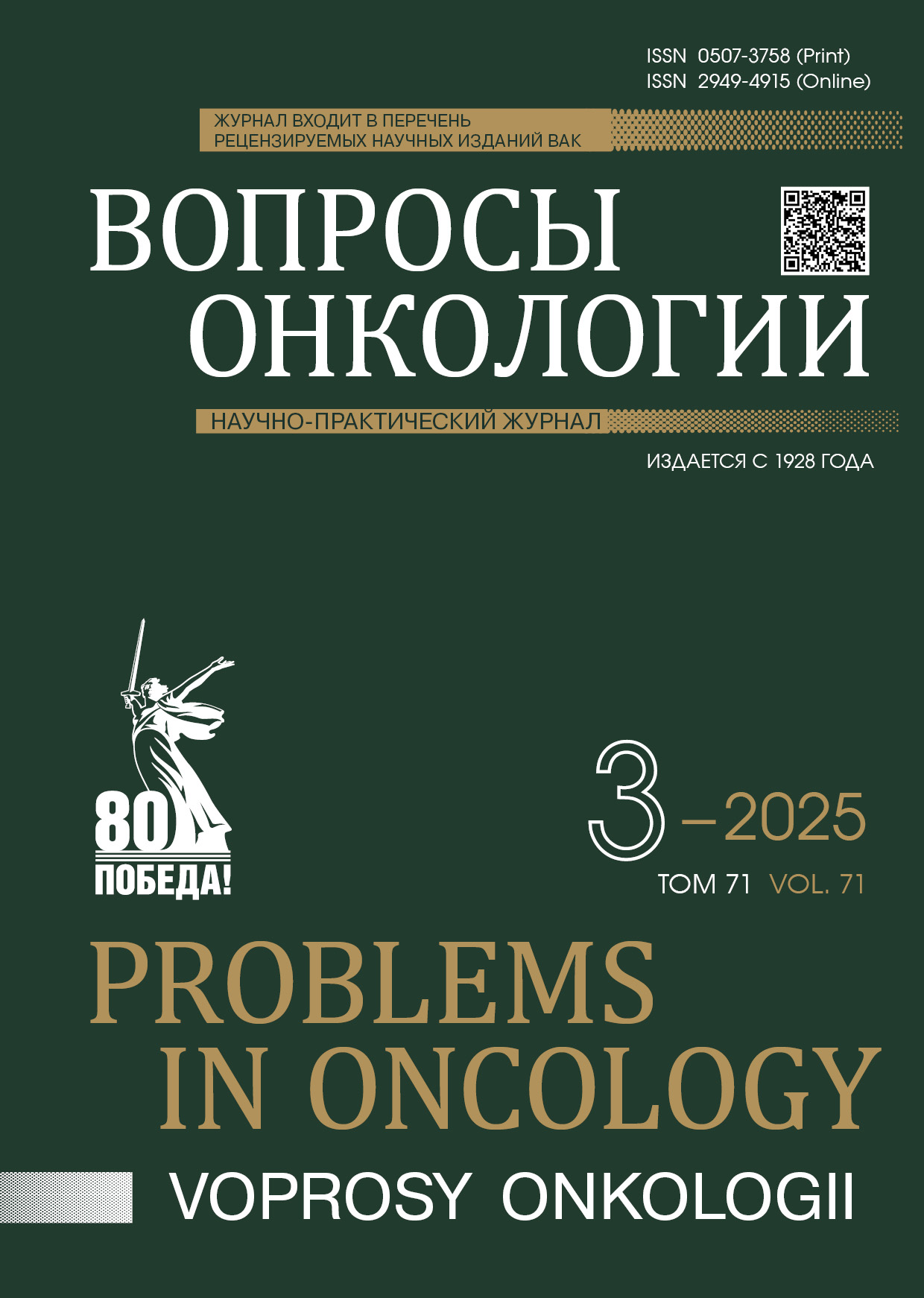Abstract
Introduction. Selecting a treatment strategy for patients with Estrogen-Receptor-positive, HER2-negative Breast Cancer (ER+HER2-BC) is a complex therapeutic challenge. Previous studies have shown that the outcomes of neoadjuvant endocrine therapy (NET) and combined chemotherapy (CT) are comparable in terms of breast-conserving surgery rates and clinical response. However, no direct comparisons have been conducted between modern anthracycline–taxane chemotherapy (A-T NACT) and NET with regard to RCB (Residual Cancer Burden). The role of NET in de-escalating chemotherapy also remains unclear.
Aim. A comparative assessment of the frequency of pathological Complete Response (pCR), RCB 0+1, and axillary pCR during NET compared to A-T NACT in stage II–III BC in postmenopausal patients. RCB 0+1 was chosen as an endpoint due to comparable long-term outcomes in ER+HER2- BC based on meta-analysis data.
Materials and Methods. A retrospective single-center study included patients with stage II–III ER+HER2-BC who underwent NET or NACT at a single center between August 2018 and November 2023.
Results. A total of 206 patients were included in the study: 96 received NET with AI, and 110 underwent A-T NACT. After pseudo-randomization, 69 patients from each group were included in the final analysis. The majority (94.2–91.3 %) had stage III disease. The median age was 64.6–58.2 years, and the median Ki67 was 34.2–39.5 %. The pCR rate was 1.4 % in the NET group vs 10.1 % in the NACT group (p = 0.06), RCB 0+1 was 4.3 vs 20.2 % (p = 0.008), and axillary clearance was 3.5 vs 27.6 % (p < 0.001). After surgery, 53.6 % of NET patients received adjuvant chemotherapy (ACT), while 46.3 % did not. The three-year Event-Free Survival (EFS) was 92.8 vs 87.0 % (p = 0.6).
Conclusion. Our preliminary results suggest that NET has a significantly lower rate of RCB 0+1 and axillary clearance than A-T NACT. However, it does not translate into differences in EFS so far, probably due to adjuvant CT, which was administered to 53.6 % of patients. NET allowed to avoid CT in 46.3 % of patients or de-escalate it (to 6 or 4xTC) in 23.2 %.
References
Park Y.H., Karantza V., Calhoun S.R., et al. Prevalence, treatment patterns, and prognosis of low estrogen receptor-positive (1 % to 10 %) breast cancer: a single institution's experience in Korea. Breast Cancer Res Treat. 2021; 189(3): 653-663.-DOI: 10.1007/s10549-021-06309-1.-URL: https://pubmed.ncbi.nlm.nih.gov/34487293/.
Jeselsohn R., Chen L., Chaudhary N., et al. Endocrine therapy resistance (ETR) in hormone receptor-positive, HER2-negative metastatic breast cancer (HR+, HER2– mBC): Prevalence, biomarker characteristics, and outcomes. JCO; 2023; 41(16): 1062-1062.-DOI: 10.1200/JCO.2023.41.16_suppl.1062.-URL: https://ascopubs.org/doi/10.1200/JCO.2023.41.16_suppl.1062/.
Yamashita H., Iwase H., Toyama T., et al. Estrogen receptor-positive breast cancer in Japanese women: trends in incidence, characteristics, and prognosis. Ann Oncol. 2011; 22(6): 1318-1325.-DOI: 10.1093/annonc/mdq596.-URL: https://pubmed.ncbi.nlm.nih.gov/21119029/.
Cortazar P., Zhang L., Untch M., et al. Pathological complete response and long-term clinical benefit in breast cancer: the CTNeoBC pooled analysis. Lancet. 2014; 384(9938): 164-72.-DOI: 10.1016/S0140-6736(13)62422-8.-URL: https://pubmed.ncbi.nlm.nih.gov/24529560/.
Yau C., Osdoit M., van der Noordaa M., et al. Residual cancer burden after neoadjuvant chemotherapy and long-term survival outcomes in breast cancer: a multicentre pooled analysis of 5161 patients. Lancet Oncol. 2022; 23(1): 149-160.-DOI: 10.1016/S1470-2045(21)00589-1.-URL: https://pubmed.ncbi.nlm.nih.gov/34902335/.
Mougalian S.S., Hernandez M., Lei X., et al. Ten-year outcomes of patients with breast cancer with cytologically confirmed axillary lymph node metastases and pathologic complete response after primary systemic chemotherapy. JAMA Oncol. 2016; 2(4): 508-16.-DOI: 10.1001/jamaoncol.2015.4935.-URL: https://pubmed.ncbi.nlm.nih.gov/26720612/.
Семиглазов В.Ф., Семиглазов В.В., Дашян Г.А., et al. Неоадъювантная эндокринотерапия пациентов с эстроген-рецептор-положительным раком молочной железы. Сибирский онкологический журнал. 2018; 17(3): 11-19.-DOI: 10.21294/1814-4861-2018-17-3-11-19.-URL: https://www.siboncoj.ru/jour/article/view/758?locale = ru_RU/. [Semiglazov V.F., Semiglazov V.V., Dashyan G.A., et al. Neoadjuvant endocrine therapy for patients with estrogen receptor-positive breast cancer. Siberian Journal of Oncology. 2018; 17(3): 11-19.-DOI: 10.21294/1814-4861-2018-17-3-11-19.-URL: https://www.siboncoj.ru/jour/article/view/758?locale = ru_RU (In Rus)].
Alba E., Calvo L., Albanell J., et al. Chemotherapy (CT) and hormonotherapy (HT) as neoadjuvant treatment in luminal breast cancer patients: results from the GEICAM/2006-03, a multicenter, randomized, phase-II study. Ann Oncol. 2012; 23(12): 3069-3074.-DOI: 10.1093/annonc/mds132.-URL: https://pubmed.ncbi.nlm.nih.gov/22674146/.
Palmieri C., Cleator S., Kilburn L.S., et al. NEOCENT: a randomised feasibility and translational study comparing neoadjuvant endocrine therapy with chemotherapy in ER-rich postmenopausal primary breast cancer. Breast Cancer Res Treat. 2014; 148(3): 581-90.-DOI: 10.1007/s10549-014-3183-4.-URL: https://pubmed.ncbi.nlm.nih.gov/25395314/.
Spring, L., Gupta, A., Reynolds, K.L., et al. Neoadjuvant endocrine therapy for estrogen receptor-positive breast cancer: a systematic review and meta-analysis. JAMA Oncology. 2016; 2(11): 1477-1486.-DOI: 10.1001/jamaoncol.2016.1897.-URL: https://pubmed.ncbi.nlm.nih.gov/27367583/.
Symmans W.F., Peintinger F., Hatzis C., et al. Measurement of residual breast cancer burden to predict survival after neoadjuvant chemotherapy. J Clin Oncol. 2007; 25(28): 4414-22.-DOI: 10.1200/JCO.2007.10.6823.-URL: https://pubmed.ncbi.nlm.nih.gov/17785706/.
Dowsett M., Smith I.E., Ebbs S.R., et al. IMPACT Trialists Group. Prognostic value of Ki67 expression after short-term presurgical endocrine therapy for primary breast cancer. J Natl Cancer Inst. 2007; 99(2): 167-70.-DOI: 10.1093/jnci/djk020.-URL: https://pubmed.ncbi.nlm.nih.gov/17228000/.
Goncalves R., DeSchryver K., Ma C., et al. Development of a Ki-67-based clinical trial assay for neoadjuvant endocrine therapy response monitoring in breast cancer. Breast Cancer Res Treat. 2017; 165(2): 355-364.-DOI: 10.1007/s10549-017-4329-y.-URL: https://pubmed.ncbi.nlm.nih.gov/28612227/.
Ellis M.J., Tao Y., Luo J., et al. Outcome prediction for estrogen receptor-positive breast cancer based on postneoadjuvant endocrine therapy tumor characteristics. J Natl Cancer Inst. 2008; 100(19): 1380-8.-DOI: 10.1093/jnci/djn309.-URL: https://pubmed.ncbi.nlm.nih.gov/18812550/.
Ma C.X., Suman V.J., Leitchet A.M., et al., ALTERNATE: Neoadjuvant endocrine treatment (NET) approaches for clinical stage II or III estrogen receptor-positive HER2-negative breast cancer (ER+HER2-BC) in postmenopausal (PM) women: Alliance A011106. JCO. 2020; 38: 504-504.-DOI: 10.1200/JCO.2020.38.15_suppl.504.-URL: https://ascopubs.org/doi/10.1200/JCO.2020.38.15_suppl.504/.

This work is licensed under a Creative Commons Attribution-NonCommercial-NoDerivatives 4.0 International License.
© АННМО «Вопросы онкологии», Copyright (c) 2025

